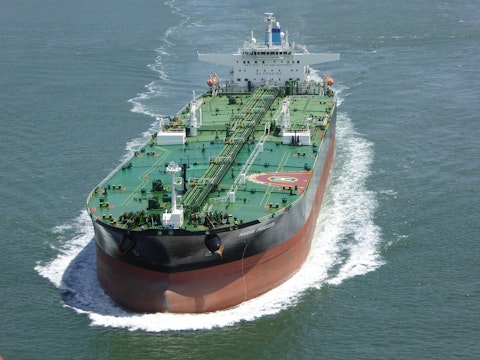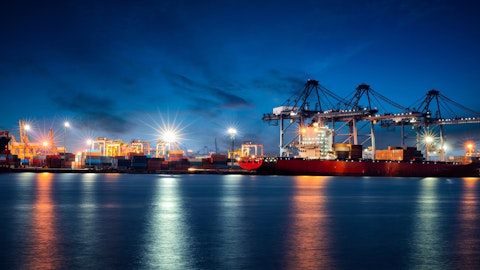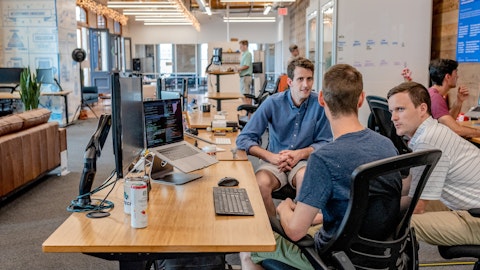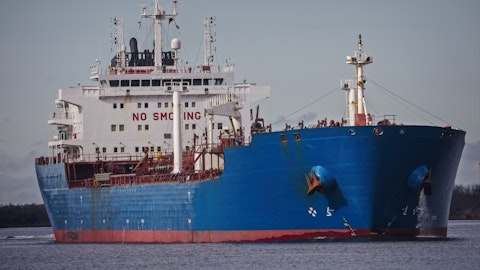KNOT Offshore Partners LP (NYSE:KNOP) Q2 2023 Earnings Call Transcript August 31, 2023
KNOT Offshore Partners LP beats earnings expectations. Reported EPS is $0.27, expectations were $-0.04.
Operator: Hello and welcome to today’s KNOT Offshore Partners’ Second Quarter 2023 Earnings Results Conference Call. My name is Jordan and I’ll be coordinating your call today. [Operator Instructions] I am now going to hand over to Gary Chapman, CEO and CFO, to begin. Gary, please go ahead.
Gary Chapman: Thank you and welcome everybody to our second quarter 2023 earnings call. The earnings release and this presentation are available on our website at knotoffshorepartners.com. Slide 2 of the presentation gives guidance on the inclusion of forward-looking statements in today’s presentation, that are made in good faith and reflect management’s current views, known and unknown risks and are based on assumptions and estimates that are inherently subject to significant uncertainties and contingencies, many of which are beyond our control. Actual results may differ materially from those expressed or implied forward-looking statements and the partnership does not have or undertake a duty to update any such forward-looking statements made as of the date of this presentation.

And for further information, please consult our annual and quarterly SEC filings. Today’s presentation also includes certain non-U.S. GAAP measures and our earnings release includes a reconciliation of these to the most directly comparable GAAP measures. On Slides 3, 4 and 5 are highlights from the second quarter of 2023 and some subsequent developments. Beginning on Slide 3, we announced our 41st consecutive quarterly cash distribution since our IPO in respect to the second quarter and which was paid in August 2023 under our 1099 structure. We had a strong operational quarter as our fleet operated with 99.3% utilization for scheduled operations and 95.5% utilization taking into account the scheduled dry dockings of the Brasil Knutsen and the Hilda Knutsen.
We successfully closed our new 5-year $240 million senior secured term loan facility in June, which was scheduled to mature in September 2023, secured by the 6 vessels listed on the slide. And in August, we also successfully closed the refinancing of our first $25 million revolving credit facility with the facility being rolled until August 2025 on similar terms. We are discussing with the lender under our second $25 million revolving credit facility, which will mature in November 2023. And we also expect this will be successfully refinanced on acceptable and similar terms prior to its maturity. Then coming to some recent contract developments. In August, we agreed a 100-day extension to the existing bareboat charter party for the Dan Cisne with Transpetro, which will extend the vessels employment to around the end of December 2023.
This is not yet signed, but it is only subject to agreements of customary documentation and we expect that it will be signed in the coming days. On August 8, 2023, we entered into a new time charter contract for the Brasil Knutsen with a major independent operator in Brazil, to commence in January 2024 for a fixed period of 1 year. We agreed with Equinor to substitute the Brasil Knutsen for the Windsor Knutsen in the time charter contract we have with Equinor that is due to commence in the fourth quarter of 2024 or the first quarter of 2025, with the time charter otherwise remaining unchanged. This allowed us to move forward and agreed commercial terms in July 2023 for a new time charter contract for the Windsor Knutsen with an oil major to commence within the window from February 1 to May 1, 2025 for a fixed period of the charterer’s option of either 1 year with an option for the charterer to extend the charter by a further year or a single firm period of 2 years.
Signing of this new contract does remain subject to the charterer’s management approval, agreements of certain operational details and customary documentation, but we are confident at this moment that this will be successfully concluded within September 2023. On Slide 4, the Hilda Knutsen and the Torill Knutsen each continue to operate on separate time charter contracts with a subsidiary of the partnership sponsor, Knutsen NYK, at a reduced charter rate and we are continuing to market both vessels for new third-party charter employment, and we are in active discussions with potential charterers, including Knutsen NYK and we hope to be able to give more details in a future release. As we have disclosed previously, in April 2023, a new time charter contract for the Recife Knutsen was signed with Transpetro for a firm period of 3 years and the vessel began operating under this new time charter contract on August 3, 2023.
Directly after the expiration of the then existing bareboat charter also with Transpetro, and the vessel is now fixed until around August 2026. The Tordis Knutsen operated under a time charter contract with a subsidiary of TotalEnergies, which expired on July 1, 2023 and on the same day, the vessel was delivered to Shell to commence on its new 3-year time charter. On August 1, PetroChina took its final option on Vigdis Knutsen, such that the time charter contract was extended by 6 more months to March 2024, after which the vessel is due to be delivered to Shell to commence on a new 3-year time charter. The Lena Knutsen operated under a time charter contract with a subsidiary of TotalEnergies, which is in fact anticipated to end today, August 31, following which the vessel will start on its new 3-year time charter contract with Shell, which we expect will start in early September 2023.
Following discussions with Ernst & Young, or EY, our auditors, in the second quarter, we recognized non-cash impairments in respect of the Dan Cisne and Dan Sabia in accordance with U.S. GAAP in a total amount of $49.6 million. This was due to the vessel’s current charter contracts moving closer to their expiry, their high carrying value and their smaller size not being optimal for the Brazilian market. These vessels are the partnerships only to smaller Panamax size vessels and we do not currently expect there to be any wider implications on the rest of the fleet from the same issue. In terms of employment of the Dan Cisne and Dan Sabia, we are actively assessing options should Transpetro or Petrobras not wish to enter into a new charter for one or both of the vessels.
And these options include a potential sale though at this stage, no decisions have been made and discussions remain ongoing as both vessels are under contract until at least the end of 2023. We expect to be able to give more details in a future release. The scheduled 10-year special survey dry dockings of the Brasil Knutsen and Hilda Knutsen commenced in the second quarter of 2023, with both dry dockings being successfully completed in Europe in July 2023. We were able to secure a cargo voyage from Brazil to Europe for the Brasil Knutsen and it allowed us to avoid incurring the majority of bunker fuel costs in transit from Brazil to the European yard and as well reduce the number of days off-hire. Following the work this quarter and beforehand, we have now essentially secured employment across the fleet for the vast majority of 2023, allowing us to focus on the gaps remaining in 2024 and beyond.
On Slide 5, the partnership had $68.1 million in available liquidity at the end of the second quarter. We had around 67% of our debt hedged or effectively operating on a fixed interest rate basis and we had $620 million of remaining contracted forward revenue, excluding charterer’s options and excluding contracts agreed or signed after June 30, 2023. The fleet was on average 9.2 years old, over a useful life of 23 years and we continue to see very encouraging tightening in the Brazilian market, a very limited newbuild order book. And although the North Sea market is still expected to take several more quarters before it begins to rise again, the supportive fundamentals of vessel supply set against the faster pace of new offshore oil production that will drive demand, we believe this partnership well placed over the coming years to benefit from our market leading position.
Slides 6, 7 and 8 are our summary of financial results for the quarter. On Slide 6, our revenues were strong in the second quarter. Operating expenses were broadly in line with our expectations, excluding the non-cash impairment charge. And although interest expenses increased over the first quarter, we are hopeful that interest rate increases may now have peaked. On Slide 7, you can see our cash and cash equivalents balance at the end of the quarter of $63.1 million and the current portion of long-term debt has reduced as the refinancings have closed. On Slide 8, which eliminates the non-cash impairment, you can see that adjusted EBITDA for the second quarter was again solid. Slide 9 shows our contractual position and the updates are also set out in the earnings release, so I won’t repeat them here.
As at June 30, 2023, excluding charterer’s options and contracts agreed after this date, we had $620 million of forward contracted revenue. And of our firm charters, these have 2 years remaining on average and charterers had options to extend these charters by further 2.2 years on average. On Slide 10, you will see that we now have contract coverage for practically the entire of 2023 and several vessels are now under contract for much longer periods as you could see on Slide 9. As a result, most of our focus has moved on to the vessels that are yet to be fixed in 2024, principally the Hilda Knutsen, Torill Knutsen, Dan Cisne and Dan Sabia and these vessels are where our main efforts are being directed. With only 5 new shuttle tankers to come into the market between now and 2026, the total supply of shuttle tankers is likely to become tight in view of oil production increases.
And with newbuild shuttle tanker prices remaining very elevated, this helps the competitiveness of our fleet. Whereas in recent years, we have been cautious about vessels nearing the end of their term periods, the balance in Brazil, in particular, is shifting. As is, while we can’t say that a given vessel option will or will not be taken up by a charterer at the end of a firm period, we are increasingly confident that either options will be exercised or we would at that time be in a good negotiating position to secure new employment. As noted, the size of the Dan vessels makes them something of an outlier for Brazil, but the majority of the fleet would be well positioned. Finally, please bear in mind that this slide does not talk to vessel utilization.
It refers to future charter contract coverage. Then on Slide 11, we list the potential drop-down vessels currently owned by our sponsor KNOT. As stated, the acquisition by the partnership of any such vessel in the future would be subject to approval of the partnership’s independent conflicts committee as well as the Board of Directors of each of KNOP and KNOT and there can be no assurance that any potential acquisitions will actually occur. As we have said, our top priorities are securing additional contract coverage, forward visibility for our existing fleet and rebuilding our liquidity position, and that remains unchanged. Slide 12. We have shown this slide before and I will just dwell on it for a moment to emphasize that we are in fact seeing these new FPSOs making their way to the Brazilian offshore region as anticipated, with Petrobras alone starting up two of them during the second quarter, indicating that another will start during the third quarter and Equinor announcing that another is currently on its way.
As a practical matter, FPSOs do not simply arrive on the scene and immediately produce at maximum capacity, but these processes are underway and building significant momentum in the manner that we had anticipated. Just as further context and as one example, Petrobras’ Mero 2 with the Sepetiba FPSO will be the largest project anticipated to startup during the second half of 2023. Once sold from China and installed in the pre-salt field, it is expected to produce around 164,000 barrels per day at its peak. With a low carbon score and low marginal cost of oil production, combined with a general need to utilize shuttle tankers for much of this growth, this hopefully helps to explain why we feel very positive with respect to the mid to long-term outlook for our business, particularly in Brazil.
And we have also retained a further slide in the appendix to this presentation that gives some more detail. On top of this, Slide 13 sets out our investment case in summary form, listing the various key attributes of our business and which helps us to explain even further why we are so positive about the partnership’s mid and long-term outlook. I won’t read these out, but hopefully, you will agree that we are able to present a very strong case. So, in summary for this quarter on Slide 14, our fleet operated with 99.3% utilization for scheduled operations and 95.5% utilization taking into account the scheduled dry dockings of the Brasil Knutsen and Hilda Knutsen and we paid our 41st consecutive distribution since the partnership listed in 2013 under our 1099 structure.
We have now largely addressed our near-term refinancing needs having successfully closed the new 5-year $240 million senior secured term loan facility, which was scheduled to mature in September 2023 and the first $25 million revolving credit facility with the facility being rolled until August 2025 on similar terms. And we expect that the second $25 million revolving credit facility, which will mature in November 2023, will also be successfully refinanced, unacceptable and similar terms prior to its maturity. We completed a new contract with the Brasil Knutsen, agreed terms for a new contract for the Windsor Knutsen, PetroChina took up their option to extend their existing charter for the Vigdis Knutsen, and we agreed a short charter extension for the Dan Cisne.
Then in the near-term, we will continue to focus on safety as our number one priority and plan for the remaining two 2023 scheduled dry docks, look to maintain high scheduled operational utilization in line with our historically strong track record, and continue to rebuild liquidity and earnings visibility by working to secure additional charter coverage, in particular, across 2024, with our focus on the Hilda Knutsen, Torill Knutsen, Dan Cisne and Dan Sabia. So overall, I believe we have had a strong and successful quarter, notwithstanding the non-cash impairments on our two smallest vessels. We have been successful in getting new charters that we acknowledge there is more to do and we have now largely addressed our near-term refinancing needs, all moving us in the right direction.
We remain committed to being open and transparent in what we are doing and delivering what we say we will. As you have hopefully heard me say many times, we believe that there are clear signs of a positive mid to long-term future. And as the partnership moves forward in the very capable hands of Mr. Derek Lowe as the new incoming CEO, CFO, I believe our and our sponsor’s decades-long experience and market leading position in the shuttle tanker sector will serve the partnership very well. Thank you very much for your time today. And I’ll now take any questions.
Operator: [Operator Instructions] We have a question from Liam Burke of B. Riley to begin. Liam, please go ahead.
Liam Burke: Hi, Gary. How are you today?
Gary Chapman: Hello, Liam. I am very well. Thank you. How are you?
See also Goldman Sachs AI Stocks: Top 10 Stock Picks and 10 Best Semiconductor ETFs.
Q&A Session
Follow Knot Offshore Partners Lp (NYSE:KNOP)
Follow Knot Offshore Partners Lp (NYSE:KNOP)
Receive real-time insider trading and news alerts
Liam Burke: Good. Thank you. I guess the 4 vessels you talked about, the 2 Dans and then the Torill and the Hilda. But taking a step back, what needs to happen for the partnership? Is it just those 4 vessels when you can get back to what has created value traditionally, a higher payout or a resumption of taking drop-downs from your sponsor?
Gary Chapman: Yes. I think just let me address that last point first. Drop-downs right now, they’re not priority for us. Clearly, it’s something that’s still there. And our focus is on other things, as we’ve said. I think if you recall, when we reduced the distribution in January, we set back then that the priority is longer-term charter visibility and building liquidity. And I think those four vessels will go a long way to helping with that. We’ve sorted out the short-term refinancing or the vast majority of it. We’ve got a couple of dry docks still to go this year, so we need to be mindful of those. And I think that the Board’s discretion really then comes into play in terms of how they view the required level of visibility and liquidity.
But certainly, those four vessels, and we’ve highlighted them for a reason because when you look at the charter diagram that is kind of where the obvious hole is at the moment and where we need to focus our efforts. And we think we’re moving in the right direction, but there’s clearly still some work to do.
Liam Burke: Well, just looking at Brazil, you have – would the Torill and Hilda makes sense to take – I know it costs a lot of money, but does it make sense to move them to the Brazilian market and charter them there?
Gary Chapman: Yes. I mean I think we’ve said previously, we certainly haven’t ruled that out, but timing really is everything there. It would cost us a fair chunk to get them down there. And we it’s an option, absolutely. But it’s all about the timing and the choice there. So I think, yes, it’s on our list of options, if you like. But I think you can be assured that we are looking at it very carefully to make sure that if we ever went down that route, we do it at the right time and for the right reasons.
Liam Burke: Great. Thank you, Gary.
Gary Chapman: Thanks, Liam.
Operator: Our next question comes from Poe Fratt of Alliance Global Partners. Poe, the line is yours.
Poe Fratt: First of all, Gary, I’d like to just congratulate you on your new position and navigator and just say that I’ve really enjoyed working with you as your – when we’ve covered KNOT Offshore. So I’ll miss you at least.
Gary Chapman: Thank you.
Poe Fratt: Yes, this is last drive. I did have a couple of questions, just a little more detail. Can you just remind me on where the Dan Cisne and the Dan Sabia have been written down to?
Gary Chapman: Yes. So the book values were in the region of 65 and we’ve taken 25 of each of them, broadly speaking.
Poe Fratt: Okay. And then how realistic is it to think that those two could be sold?
Gary Chapman: Yes. I mean, of course, it’s always an option. And I think the discussions that the Board has had, encompasses all sorts of things. So our first choice is always to utilize the vessels, utilize them for a good charter rate, run them very well. It’s only when that doesn’t become an option that we start to look at other things. But obviously, you have to factor in time, and we can’t leave those discussions until the very last moment. We need to start thinking about them now. So again, in the interest of transparency, we’ve mentioned that on this call and in this earnings release. But we’re far from having made any decisions about that. We don’t know that the vessels won’t be taken by either Transpetro, Petrobras or another charterer.
The problem being is that today, we don’t know that they will either. The vessels have been on very long-term charters, bareboat charters. They’ve been very, very busy. The Brazilian market is tightening, as we’ve said. And although the environment in Brazil isn’t optimum for those smaller vessels today, with an absence of other vessels in Brazil, who used to say what might happen. So sale is possible. I think it’s arguably, perhaps the slightly harder option, particularly if we’re trying to sell it into a conventional market. But I think we’ve got other options before that. And certainly, our preference is to seek a new charter and run it to the shuttle tanker.
Poe Fratt: Great. And what is the more optimal market for those two? You said that Brazil are smaller, there’s – it’s suboptimal. Is there a more optimal market out there? In the shuttle tanker market. You just talked about the convention market in the shuttle tanker.
Gary Chapman: Yes. If you force me to answer that question, I would say they’re probably slightly more suited to the North Sea. They’re not North Sea compatible at the moment, but they could be made to be, so that is also an option. But clearly, right now, as we sit here today, perhaps the North Sea, transferring them immediately to the North Sea, it wouldn’t be a sensible idea. But nonetheless, both of them are contracted to the end of 2023 anyway. So we’ve still got several months before we even need to do anything with them. So that’s why at this stage, we just want people to be aware that we are looking at all options in case we aren’t able to secure a new charter at the end of these ones.
Poe Fratt: Great. And how much time and money would it take to make them North Sea compatible?
Gary Chapman: It’s not like – it’s not a huge conversion exercise like trying to convert a conventional vessel into a shuttle tanker. It’s equipment, and it’s substantial, but it’s not – I don’t think it’s something that our investors need to be concerned about from a material CapEx perspective. It’s something that we would bake into a transaction or a decision to bring them to the North Sea if that’s what we decide to do.
Poe Fratt: Okay, thanks. And then the loss of higher revenues that came in $1.3 or $1.4 million. What were they associated with?
Gary Chapman: Yes, they would all go back to slightly historic, and I would say slightly historic because it’s probably in the last one, two, three quarters of claims. So if you go back to some of our previous earnings releases, we have disclosed some of the more material off-hires that we suffered in terms of vessels suffering a few problems when we claimed on insurance. And that money coming through is a closure of those insurance claims from previous quarters. Under U.S. GAAP, you have to be really sure that you’re going to get the money before you can book it. So we always end up with a mismatch between when we put the insurance claim in and know about the problem on a ship, when we actually get the money in and we can recognize it in the accounts.
Poe Fratt: And I think I read that you don’t have any additional claims outstanding at this point in time?
Gary Chapman: Yes, yes, that’s right.





